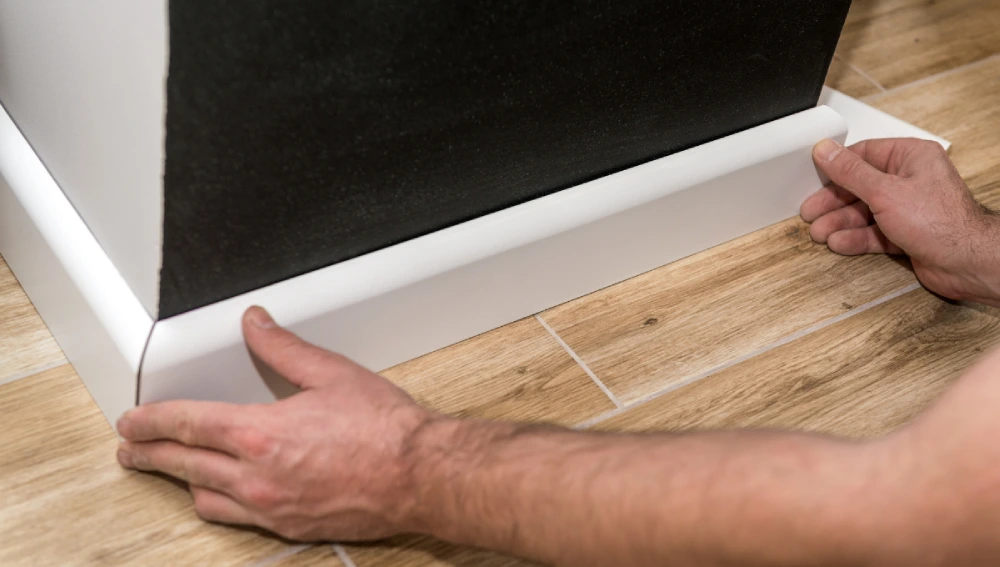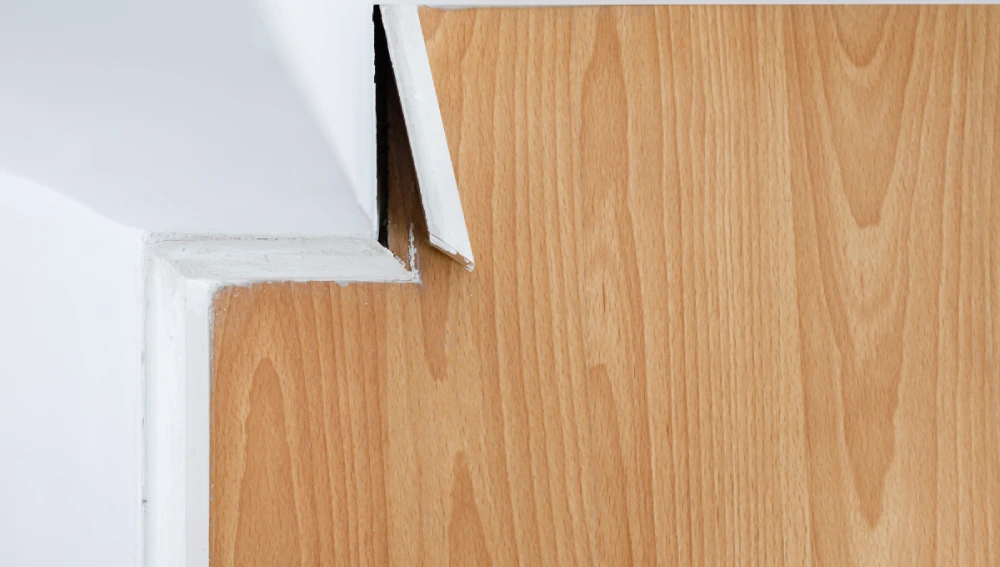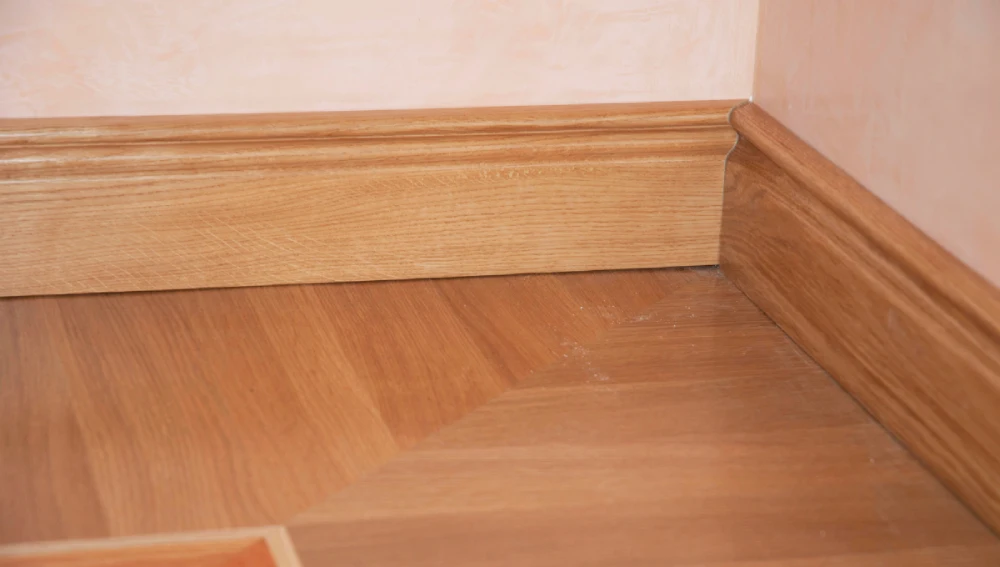What is Skirting in Construction
Skirting is a strip of material. It’s usually made of wood, plastic, or tile. which is installed along the bottom of the walls where they meet the floor. It covers the joint between the wall and the floor provides a neat finish and protects the walls from damage.
Importance of Skirting

Aesthetic Appeal
Room Decor Enhancement: Room decor can be improved with skirting. It is a decorative feature on the joint of a wall and the floor. This makes for a smooth transition and enhances the appearance of the space. Skirting may also be designed to suit your room’s décor, whether it is traditional, modern, or minimalist.
Customization: Manufacturers make skirting boards in different materials, colors, and styles. Consequently, homeowners and interior designers have endless possibilities when searching for ideas that match their house designs best. Wood skirting could also be stained or painted having a similar finish as furniture or lighting fixtures. PVC skirting comes in many colors to match walls or floors.
Protection
- Wall Protection: The main purpose of using skirting boards is to protect walls from damage at low levels. Shoes, vacuum cleaners or collisions cause dents to walls in busy areas where people pass by every time. That way is gone now because of such problems that are common among others.
- Furniture Damage Prevention: Removal of furniture frequently results in writing and damage on walls. Skirting provides a buffer. It ensures that when furniture is moved, it does not directly hit and damage the walls. This is especially useful in homes with heavy or frequently moved furniture.
- Durability: In business places or homes where children and animals are found, skirting is made of either PVC or metal which is one of the most suitable materials that can be used to make it because they can withstand a lot of pressure resulting from different destructive activities carried out by human beings. These materials are capable of withstanding a lot of stress hence preserving the walls for a long period.
Concealing Gaps
- Covering Construction Imperfections: During construction, it is common to have small gaps or uneven edges where the wall meets the floor. Skirting effectively hides these imperfections, providing a neat and polished finish to the room.
- Seamless Finish: Skirting conceals gaps. It ensures the wall-to-floor transition looks smooth and unbroken. This seamless finish contributes to the overall aesthetic of the room, making it look professionally designed and well-maintained.
- Maintenance of Clean Lines: Skirting helps in maintaining clean lines in interior design. Straight and even skirting boards can emphasize the shape of a room. They highlight its features and add to a more orderly and appealing space.
Concealing Wiring
- Hiding Electrical Cables: Modern homes and offices have many electrical cables for power, internet, and entertainment. Skirting can have cable management features. They hide wires, reducing clutter and making the area safer.
- Easy Access: Skirting boards that conceal wiring also allow for easy access when needed. Unlike wires buried in walls, cables behind skirting can be quickly reached for maintenance or upgrades without damaging the wall.
- Safety: Exposed wires can be a tripping hazard and pose a risk of electrical accidents. By concealing wiring within skirting, these risks are minimized, making the space safer for inhabitants, especially children and pets.
Types of Skirting

There are a number of types of skirting boards that cater for different needs and tastes.
- Wooden: This variant is made of various woods and can add warmth and an organic look to your interior. There are many ways to finish this product including polishing, painting or varnishing.
- PVC: It is made from plastic so it is very durable and easy to clean. If you have chosen such a style for your apartment, you can diversify the designs and colors.
- Metal: These metal skirtings are usually constructed from stainless steel or aluminium. It is commonly used in modern or industrial interiors. The material itself is tough and resistant to damage.
- Tile: In bathrooms as well as kitchens, these parts match floor tiles while serving as water proofing against walls.
Applications of Skirting
Living Rooms
Suitable Type of Skirting Used: Wooden Skirting
Why Wooden Skirting?:
Aesthetic Appeal: Wooden skirting can add a sense of sophistication and homeliness to living rooms. It is paintable or stainable so that it can be matched or contrasted with other wooden pieces of furniture, doors and floors the room has.
Durability: Wooden skirting is strong enough to resist minor impacts making it the best option for places where people keep moving their furniture most of the time.
For example, in a modern living room with wooden flooring and furniture, there are some wooden skirtings at the bottom of walls. To achieve this uniform elegant look, the skirting was stained dark as per the rich colour of the furniture. It also keeps scuffs away from walls when chairs and sofas are being put in place.
Kitchens
Suitable Type of Skirting Used: Tile Skirting
Why Tile Skirting?
Hygiene: Kitchens are prone to spills and splashes. Tile skirting is easy to clean and will keep looking good over time, making it a hygienic option.
Waterproofing: A tile skirting provides a waterproof barrier preventing water from getting into the walls.
For Example, when in an active kitchen with tiles covering its floor, matching tile skirting extends along the base of its walls. This blending approach not only appears neat and up-to-date but also insulates any water damage on the wall surfaces as well as ease off cleaning after spillages. The choice for tile skirting is made in accordance with the floor tiles that are consistent throughout the kitchen.
Offices
Suitable Type of Skirting Used: PVC or Metal Skirting
Why PVC or Metal Skirting?
Durability: Both PVC and metal skirting are highly durable and can withstand high foot traffic, which is common in office environments.
Concealing Wiring: These materials often come with channels to conceal electrical wiring, keeping the office space tidy and reducing clutter.
For example, In a commercial office space with carpet flooring, PVC skirting with built-in cable management channels is installed. The skirting helps hide numerous computer and telephone wires, creating a neat and organized environment. The PVC material is chosen for its durability and ease of maintenance, ensuring it looks good even with heavy daily use.
Bathrooms
Suitable Type of Skirting Used: Tile Skirting
Why Tile Skirting?:
Waterproof: When you build bathrooms in wet areas, tile skirtings help ensure water does not pass through walls.
Easy to Clean: Cleaning bathroom corners can present a challenge, but tile skirting makes it easier for us to wash them clean when necessary.
For Example, In contemporary bathrooms with ceramic floor tiles, matching ceramic tile skirting is used along the walls. This waterproof option guarantees that showers or sink splatters do not damage adjacent surfaces. Such tile baseboards also tie into an overall bathroom theme perfectly well providing that seamless fresh appearance.
Bedrooms
Suitable Type of Skirting Used: Wooden or MDF (Medium Density Fiberboard) Skirting
Why Wooden or MDF Skirting?:
Aesthetic Consistency: Wooden or MDF skirting can be painted or stained to match the bedroom decor, providing a consistent and pleasing appearance.
Cost-Effective: MDF skirting is a cost-effective alternative to solid wood, offering similar aesthetic benefits at a lower price.
For example, In a cozy bedroom with hardwood floors, MDF skirting is installed and painted in a soft white color to match the room’s trim and furniture. This creates a serene and harmonious environment.
Hallways and Corridors
Suitable Type of Skirting Used: PVC or Metal Skirting
Why PVC or Metal Skirting?:
High Traffic Resilience: Hallways and corridors experience heavy foot traffic, and PVC or metal skirting is durable enough to withstand constant use.
Ease of Maintenance: These materials are easy to clean and maintain, which is important for high-traffic areas.
For Example, In a school corridor, metal skirting is installed along the walls. The metal skirting is chosen for its robustness and ability to endure the wear and tear of daily student activities. Its sleek, modern appearance also adds to the overall aesthetic of the hallway.
Retail Spaces
Suitable Type of Skirting Used: PVC Skirting
Why PVC Skirting?:
Versatility: PVC skirting is available in various colors and styles, making it suitable for different retail interiors.
Durability: It is resistant to impacts and scratches, which is crucial in busy retail environments.
For Example, In a retail clothing store, PVC skirting is installed along the base of the display walls. The skirting is in a neutral color that matches the store’s interior design. It protects the walls from damage caused by shopping carts and foot traffic, while also keeping electrical wiring out of sight.
Conclusion
Skirting is a key part of interior construction. It is versatile and essential. It provides both aesthetic and functional benefits in many uses. Choosing the right skirting for each area will enhance the look of the space and protect walls. It will also ensure a clean and organized environment.
Skirting is important in interior spaces. It warms a living room with wood and gives durability to an office with PVC. Tile adds hygiene to kitchens and bathrooms.
FAQs
Skirting serves multiple purposes: it hides the gaps between the wall and the floor, protects walls from damage caused by furniture or cleaning, and enhances the overall aesthetic of the interior space.
While not mandatory, skirting is commonly used in residential and commercial buildings for aesthetic purposes and to protect walls. It may not be necessary in industrial or minimalist designs.
Skirting is typically installed after the flooring is laid. It is cut to size and fixed to the wall using adhesive, nails, or screws, depending on the material and the surface. The joints are then sealed for a seamless finish.

